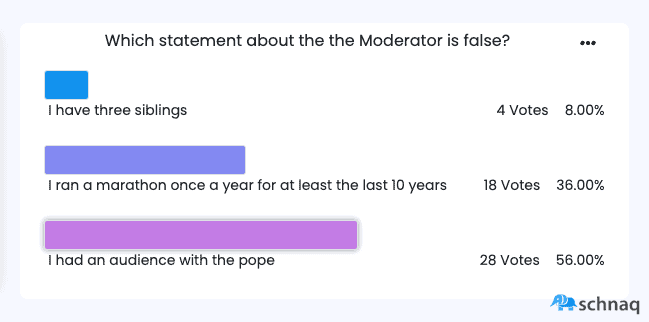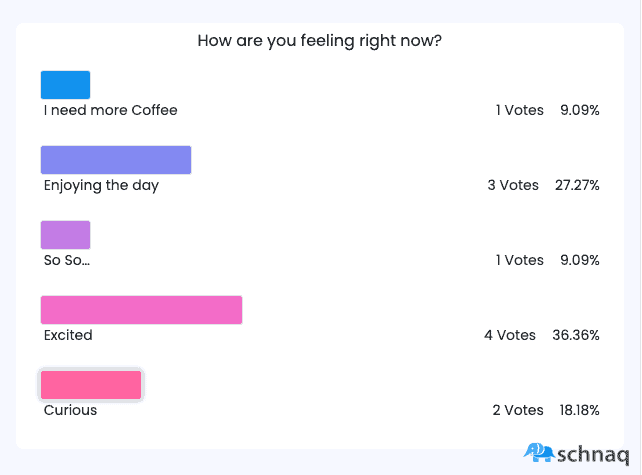You are in charge of a hybrid or online event, and you want to start it as interactively as possible? Icebreakers are perfect for beginning the show with a bang.
Some people have a negative picture of overdone icebreakers. That is because of bad icebreakers that do not add value. We prepared a few Dos and Don’ts that help you produce perfect icebreakers. This way, you’ll be able to use only the most entertaining and fitting icebreakers for your event.
How to choose the optimal icebreaker
When choosing the optimal icebreaker for your event, you should focus on who is in the audience. You are using icebreakers because you want them to participate. The same icebreaker that is a hoot at an event full of teenagers will probably not work so well for an audience consisting of seasoned company CEOs.
But, how do you choose the right icebreaker for your audience? Think about the following five things:
- Make it interactive
- Make it not embarrassing or threatening
- Make it fun
- Make it time-appropriate
- Make it relevant to the audience
Interactivity
Try to choose interactive icebreakers. For example, icebreakers that require interaction with other people work well more often. On the opposite, icebreakers, where people have to answer questions all by themselves, are not well received.

Not embarrassing or threatening
Don’t use icebreakers that might make some of the people in the audience feel unwell. It should be a no-brainer, but it helps to purposefully think about which activities might be unfit for your audience.
Fun
Make your icebreakers fun. There is no substitute for it. Icebreakers might be appropriate and interactive. But, as long as the fun is missing, they will not be very motivating for the participants.
Make it time-appropriate
Not all icebreakers fit into the schedule, group size, and possibly room size. For example, some activities take up extra time per person involved. Those activities are then only appropriate with a smaller audience. Other icebreakers require everybody to participate at once and are perfect for any audience.
Make it relevant to the audience
Does your icebreaker check the four attributes above? Add the cherry on top: Choose an icebreaker relevant to the participants and the event. It feels more natural and encourages people to participate more.
Ten ideal icebreakers for you to try
Now that you know how to choose the perfect icebreaker, we have prepared ten methods from which you can choose.
1. Two truths and a lie
Everybody knows this game from at least their teenage days. You make three statements. Two of those are truthful, and one is a lie. Now you let your audience guess which one is the lie. Of course, you need to make it somewhat believable. Optimally, you can use a polling tool to visualize the guesses of your audience.

Read Also: The Ultimate Guide to Online Polls: Benefits and Best Practices
2. Storytelling rounds
The simplest form of an icebreaker is storytelling rounds. You ask a question and go around the audience listening to the answers. Design the question in a way that will produce fun, inspiring statements or stories. For example:
- What was the most inspiring thing you did this year?
- Which memory makes you laugh when you think about it?
This only works with small or medium audiences. Otherwise, it takes too much time, or you can not involve everybody.
3. Q&As
Yes, Q&As also work as an icebreaker. Split your audience up into small groups of no more than four people. And then give them five minutes to discuss questions they would like to pose to the speaker or a panel of speakers. This way, they will get to interact with each other.
A Q&A tool, where every team collects their questions simultaneously, helps.

4. Show and tell
For show and tell, you just let everybody show an object they have on hand / on their desk and explain why it was there. You can also try variants, like people showing off their pets or kids. That is one of the cases where you need to check whether your audience is comfortable with that.
5. Play a game
For small audiences playing a short game works wonderfully as an icebreaker and involves everybody in a fun way. You could, for example, play a round of “Guess Who?”. You pick a person that the audience needs to guess. Everybody, ruled out by the questions, turns off their camera. For more inspiration, you can read our article on games you can play in online workshops.
6. Mood Barometer
Prepare a poll with a question asking for the mood of the audience. You can go with a simple scale from one to ten. Or you have more articulated options like “I need more coffee” or “Enjoying the weather.”
You can have a few mood barometers after each other since they take up virtually no time.

7. Push the button
For this game, you need some form of signal or button everybody in the audience can press. You could use schnaqs quick-activation button for that.
You pose a difficult question and let the participants decide if they want to press the button and how often. For example: “You press the button and get to spend a day with your favorite actor/actress, but you will not be able to speak for the day.”

8. Guess the sound
The principle is simple: Somebody makes a sound while the rest has to guess what that sound was. It does not matter if the sound is made with the mouth or through an object.
The person guessing the sound can be the next in line to produce a sound.
9. Three Hashtags
This icebreaker works best when there is not much time. Go around the room and let everybody state a name and three hashtags that best represent them.
10. Wordcloud Feedback
For this icebreaker, you need a word cloud visualization. Then ask a question where the answer is no longer than a few words. If it’s an online event, you could ask where the people currently are. It is fun to see the word cloud grow and change as people enter their answers.

